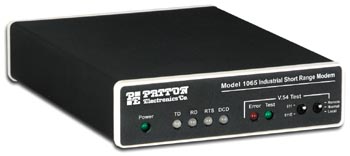|
Model 1065 Series
|
|
AC Powered, Synchronous & Asynchronous, Industrial-Grade,
Short-Range, Baseband Modems (Environmentally Enhanced)
|
|
Environmentally Enhanced Baseband Modem Supports Synchronous or
Asynchronous Data Rates up to 64 kbps at Distances up to 12 Miles (19.2
km)
|
|
|
|
|
|
|
|
|
Features & Benefits |
- Synchronous or asynchronous operation
- Supports data rates up to 64.0 kbps
- Two-wire/half duplex or four-wire/full or half duplex
- V.52 & V.54 test modes
- Equalization
- Anti-streaming timer
- Distances up to 12 miles (19.2 km)
- Point-to-point or multipoint
- Internal, external or received loopback clocking
- 2000 VAC transformer isolation & high speed surge protection
- Internal power supply
- Mono-color LED indicators
- Mounts in Patton?s 14-card rack chassis
|
|
|
|
Overview |
|
|
The Model 1065 Industrial Short Range Modem operates 2-wire (half duplex)
or 4-wire (full or half duplex), in synchronous or asynchronous modes,
over unconditioned telephone lines, supporting bit rates up to 64.0 kbps.
The Model 1065 operates in synchronous mode between the local and remote
modems; when connected to an asynchronous RS-232 device, the Model 1065
SRM converts the asynchronous data to synchronous data. The Model 1065 is
available in a standalone or rack mount package. The rack mount unit
offers redundant AC or DC power supply options that protect against
power-related failures, providing fault-tolerant operation. Power is
provided to the standalone unit through an internal AC (230 or 120 V)
power supply.
For centralized data centers, users can cluster up to 14 1065RC modem
rack cards in the Model 1001 rack chassis. The Model 1001 rack system
includes redundant power supply options that protect against power-related
failures, providing fault-tolerant operation.
The Model 1065 has several features to enhance overall performance:
equalization, anti-streaming timer, transformer isolation to guard against
data loss due to ground potential differences, and Silicon Avalanche Diode
surge protection to guard against data line transients. The Model 1065
features V.52 compliant bit error rate pattern tests and two V.54 test
modes: local analog loopback and remote digital loopback. The operator at
the local end may test both local and remote modems, plus the line, in the
digital loopback mode. Both RDL and LAL modes can be controlled by a
manual switch or via the V.24/RS-232 interface. |
|
|
1065/A/120
|
Async/Sync Industrial Baseband Modem, DB25F, RS-232, RJ-45 Line,
Desktop, 120 VAC power |
1065/A/230
|
Async/Sync Industrial Baseband Modem, DB25F, RS-232, RJ-45 Line,
Desktop, 230 VAC power |
1065E/A/230
|
Async/Sync Industrial Baseband Modem, Extended Environmental, DB25F,
RS-232, RJ-45 Line, Desktop, 120 VAC power |
|
1065E/A/230 |
Async/Sync Industrial Baseband Modem, Extended Environmental, DB25F,
RS-232, RJ-45 Line, Desktop, 230 VAC power |
|
1065E/A/230/F-CXR |
Model 1080SMBF-80; Async/Sync Industrial Baseband Modem, DB25F,
RS-232, RJ-45 Line, Desktop, 230 VAC power, French Power Cord |
|
1065RC/A/B |
Async/sync, DB25F, RS-232, RJ-45 line, rack card |
|
1065RCE/A/B |
Async/sync, extended environmental, DB25F, RS-232, RJ-45 line, rack
card
|
|
|
|
Transmission Format: Synchronous or asynchronous, 2- wire/half
duplex, or 4-wire/full or half duplex
Interface: RS-232 (CCITT V.24) connection via DB-25 female; twisted
pair connection via RJ-45
Transmission Line: 2 or 4-wire UTP, 19 - 26 AWG
Data Rate: Model 1065 - Synchronous or asynchronous at 1.2, 1.8,
2.4, 3.6, 4.8, 7.2, 9.6, 14.4, 19.2, 28.8, 38.4, 57.6 and 64 kbps?switch
selectable
Applications: Point-to-point or multi-point
Indicators: Mono-color LED indicators for TD, RD, RTS & DCD; single
LED indicators for Power, Test, and Error RTS Anti-stream Timer 12.5 sec.,
50 sec., or disabled (switch selectable); tolerance: +50%, -0
Clocking: Internal, external or receive recover
Controls: Carrier constantly ?ON? or ?controlled by RTS?; RTS/CTS
delay set to no delay, 7 or 53 ms
Diagnostics: V.52 compliant bit error rate pattern (511/511E
pattern) generator and detector with error injection mode; V.54
compliant?Local Analog Loopback and Remote Digital Loopback, activated by
front panel switch or via RS-232 interface
Transformer Isolation: 2000 V RMS
Surge Protection: Immune to IEC-801-5 Level 2, 1kV
Temperature: -10?C to 70?C
Humidity: 100% condensing from -10?C to +30?C Absolute humidity
from +30?C to +70?C
Dimensions: 5.5? (W) X 7.5? (D) X 1.6? (H) (13.9 cm X 19 cm X 4 cm)
Power Supply: 157-242 VAC Universal Interface
|

